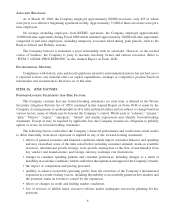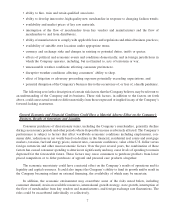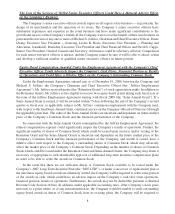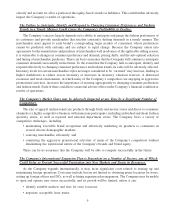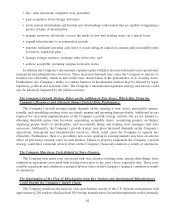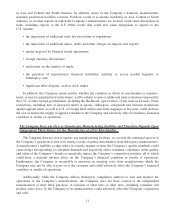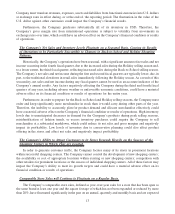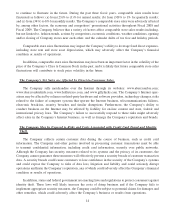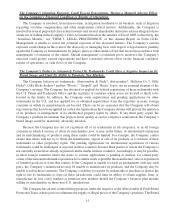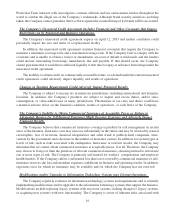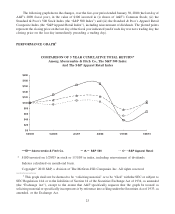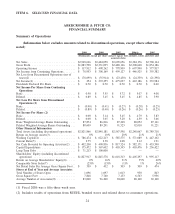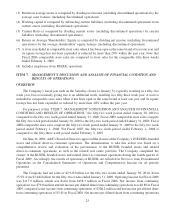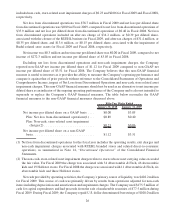Abercrombie & Fitch 2009 Annual Report Download - page 17
Download and view the complete annual report
Please find page 17 of the 2009 Abercrombie & Fitch annual report below. You can navigate through the pages in the report by either clicking on the pages listed below, or by using the keyword search tool below to find specific information within the annual report.
Protection Team interacts with investigators, customs officials and law enforcement entities throughout the
world to combat the illegal use of the Company’s trademarks. Although brand security initiatives are being
taken, the Company cannot guarantee that its efforts against the counterfeiting of its brands will be successful.
The Company’s Unsecured Credit Agreement Includes Financial and Other Covenants that Impose
Restrictions on its Financial and Business Operations.
The Company’s unsecured credit agreement expires on April 12, 2013 and market conditions could
potentially impact the size and terms of a replacement facility.
In addition, the unsecured credit agreement contains financial covenants that require the Company to
maintain a minimum coverage ratio and a maximum leverage ratio. If the Company fails to comply with the
covenants and is unable to obtain a waiver or amendment, an event of default would result, and the lenders
could declare outstanding borrowings immediately due and payable. If that should occur, the Company
cannot guarantee that it would have sufficient liquidity at that time to repay or refinance borrowings under the
unsecured credit agreement.
The inability to obtain credit on commercially reasonable terms, or a default under the current unsecured
credit agreement, could adversely impact liquidity and results of operations.
Changes in Taxation Requirements Could Adversely Impact Financial Results.
The Company is subject to income tax in numerous jurisdictions, including international and domestic
locations. In addition, the Company’s products are subject to import and excise duties, and/or sales,
consumption, or value-added taxes in many jurisdictions. Fluctuations in tax rates and duties could have
a material adverse effect on the financial condition, results of operations, or cash flows of the Company.
The Company’s Inability to Obtain Commercial Insurance at Acceptable Prices or Failure to
Adequately Reserve for Self-Insured Exposures Might Increase Expenses and Adversely Impact
Financial Results.
The Company believes that commercial insurance coverage is prudent for risk management in certain
areas of the business. Insurance costs may increase substantially in the future and may be affected by natural
catastrophes, fear of terrorism, financial irregularities and other fraud at publicly-held companies, inter-
vention by the government and a decrease in the number of insurance carriers. In addition, for certain types or
levels of risk, such as risks associated with earthquakes, hurricanes or terrorist attacks, the Company may
determine that we cannot obtain commercial insurance at acceptable prices, if at all. Therefore, the Company
may choose to forego or limit the purchase of relevant commercial insurance, choosing instead to self-insure
one or more types of risk. The Company is primarily self-insured for workers’ compensation and employee
health benefits. If the Company suffers a substantial loss that is not covered by commercial insurance or self-
insurance reserves, the loss and attendant expenses could harm its business and operating results. In addition,
exposures exist for which no insurance may be available and for which the Company has not reserved.
Modifications and/or Upgrades to Information Technology Systems may Disrupt Operations.
The Company regularly evaluates its information technology systems and requirements and is currently
implementing modifications and/or upgrades to the information technology systems that support the business.
Modifications include replacing legacy systems with successor systems, making changes to legacy systems,
or acquiring new systems with new functionality. The Company is aware of inherent risks associated with
16


